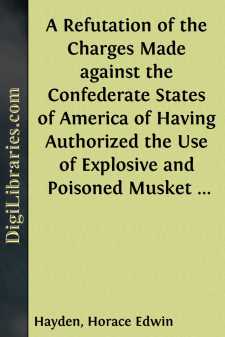Categories
- Antiques & Collectibles 13
- Architecture 36
- Art 48
- Bibles 22
- Biography & Autobiography 813
- Body, Mind & Spirit 142
- Business & Economics 28
- Children's Books 17
- Children's Fiction 14
- Computers 4
- Cooking 94
- Crafts & Hobbies 4
- Drama 346
- Education 46
- Family & Relationships 57
- Fiction 11829
- Games 19
- Gardening 17
- Health & Fitness 34
- History 1377
- House & Home 1
- Humor 147
- Juvenile Fiction 1873
- Juvenile Nonfiction 202
- Language Arts & Disciplines 88
- Law 16
- Literary Collections 686
- Literary Criticism 179
- Mathematics 13
- Medical 41
- Music 40
- Nature 179
- Non-Classifiable 1768
- Performing Arts 7
- Periodicals 1453
- Philosophy 64
- Photography 2
- Poetry 896
- Political Science 203
- Psychology 42
- Reference 154
- Religion 513
- Science 126
- Self-Help 84
- Social Science 81
- Sports & Recreation 34
- Study Aids 3
- Technology & Engineering 59
- Transportation 23
- Travel 463
- True Crime 29
A Refutation of the Charges Made against the Confederate States of America of Having Authorized the Use of Explosive and Poisoned Musket and Rifle Balls during the Late Civil War of 1861-65
Categories:
Description:
Excerpt
EXPLOSIVE AND POISONED MUSKET AND RIFLE BALLS.
The following remarkable statement occurs as a note to the account of the battle of Gettysburg, on page 78, volume III, of "The Pictorial History of the Civil War in the United States of America, by Benson J. Lossing, LL. D.":
Many, mostly young men, were maimed in every conceivable way, by every kind of weapon and missile, the most fiendish of which was an explosive and a poisoned bullet, represented in the engraving a little more than half the size of the originals, procured from the battlefield there by the writer. These were sent by the Confederates. Whether any were ever used by the Nationals, the writer is not informed. One was made to explode in the body of the man, and the other to leave a deadly poison in him, whether the bullet lodged in or passed through him.
Figure A represents the explosive bullet. The perpendicular stem, with a piece of thin copper hollowed, and a head over it of bullet metal, fitted a cavity in the bullet proper below it, as seen in the engraving. In the bottom of the cavity was fulminating powder. When the bullet struck, the momentum would cause the copper in the outer disc to flatten, and allow the point of the stem to strike and explode the fulminating powder, when the bullet would be rent into fragments which would lacerate the victim.
In figure B the bullet proper was hollowed, into which was inserted another, also hollow, containing poison. The latter being loose, would slip out and remain in the victim's body or limbs with its freight of poison if the bullet proper should pass through. Among the Confederate wounded at the College were boys of tender age and men who had been forced into the ranks against their will.
The italics I am responsible for. It is difficult for those who live at the South to realize how extensively such insinuating slanders as the above against the Confederates are credited at the North, even by reading people.
I purpose in this paper to examine the statement of the author of this Pictorial History, and to show, by indisputable proof, its recklessness and its falsity. In the above quotation, he states that he had picked up, on the battlefield of Gettysburg, an explosive and a poisoned ball. "These," he adds, "were sent by the Confederates. Whether any were ever used by the Nationals, the writer is not informed." I do not desire to be severe beyond justice; but it does seem that as no one ventured to inform him to the contrary, this author accepted the silence of the world and deliberately put into print this slander against the Confederates without having made any apparent effort to learn, as he could have done with ease, whether his statement had any basis of truth.
It is with entire confidence in the facts presented in this paper that I deny this author's statement, above, to be a statement of fact. I do more than this—
I. I most emphatically deny that the Confederate States ever authorized the use of explosive or poisoned musket or rifle balls.
II. I most emphatically assert that the United States did purchase, authorize, issue and use explosive musket or rifle balls during the late civil war, and that they were thus officially authorized and used at the battle of Gettysburg....


